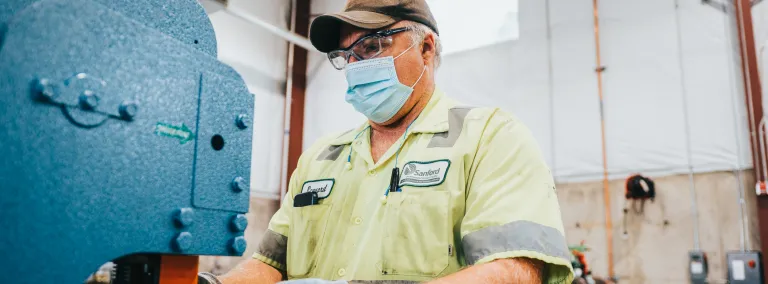Rounds Operations Center supports operations vital to SURF mission
Research at the Sanford Underground Research Facility (SURF) tackles some of humanity’s biggest questions, from why matter exists to where the Universe’s missing matter is hidden. And every day, SURF’s operations team works to make the facility a safe and reliable space in which researchers can investigate those questions. Now, this team has a centralized, full-outfitted space to streamline their efforts.
Last month, SURF dedicated the new M. Michael Rounds Operations Center (ROC). The 26,000 square foot building was completed in 2021 and houses a maintenance shop, warehouse and office space.
“The ROC has allowed us to co-locate our warehouse, mechanics, electricians, fabricators, engineering disciplines and operations management under one roof,” said William McElroy, operations division director for the South Dakota Science and Technology Authority (SDSTA). “This facility better positions the SDSTA to efficiently provide support to our science customers. That’s what it’s all about.”
A new space for work
The ROC houses a centralized location for the maintenance crews and their equipment, which were formerly located in various buildings throughout the site. The maintenance shop includes multiple bays dedicated to metal fabrication, mechanical and electrical and electronics work.
“The building brings everyone into one space, so these different crews can help each other,” said Dan Regan, buildings and ground foreman at SURF. “The space consolidates our efforts and makes our work more efficient.”
For Leonard Burtzlaff, a facilities technician at SURF, the move is a game changer.
Much of Burtzlaff’s time is devoted to metal fabrication for SURF’s dewatering pumping system. But he supports SURF’s operations in a variety of ways. His recent projects include resizing iron washers for timbers in the Yates Shaft, fixing a sagging door, fabricating metal frameworks to hold electrical panels aloft, and custom-fitting a trailer to transport tools through narrow, underground drifts.
In the ROC’s maintenance shop, Burtzlaff’s new workspace is adjacent to other crews with whom he frequently collaborates. It is outfitted with new metal fabrication equipment, including a circular cold saw, ironworker and a bandsaw.
“This facility and equipment gives us a lot more choices for our work,” Burtzlaff said. “And the machinery can be used for any project across the facility.”
Tracking SURF’s supplies
The building also includes a warehouse facility. The facility serves every SURF department, tracking and storing inventories from coffee and lightbulbs to electrical wire and rigging equipment.
The previous warehouse’s location at the Ross Campus was accessed through a residential area. It also had multiple floors and rooms, which posed organizational challenges.
“The new warehouse makes it easier to track things going in and out,” said Tim Havens, who has managed SURF’s warehouse for 12 years. And with the location, delivery traffic can bypass residential neighborhoods.
Under one roof
The center of the building houses office space for SURF’s operations and engineering departments. Bringing these departments together under one roof allows crews to communicate and collaborate on projects across the facility.
The $6.5 million needed to build the facility was provided by former Governor Dennis Daugaard and current Governor Kristi Noem across two future fund grants. “The ROC would not be a reality if it wasn’t for the contribution of the State of South Dakota,” McElroy said. “Just a few years ago, it would have been hard to imagine such a facility.”
The ROC provides SURF staff with the facility and tools needed to safely operate and maintain the deepest underground science facility in the United States—and one of the leading underground science laboratories in the world.
